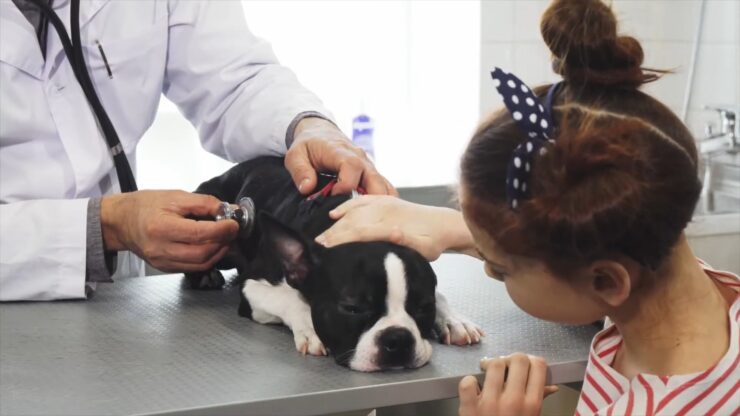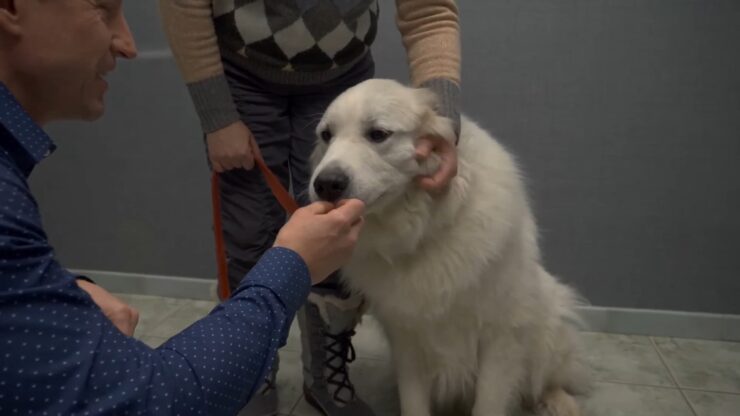Have you just observed that your dog’s skin is pink and you’re not sure if that’s normal or a cause for concern? Here’s what you need to know about your dog’s skin color.
Typically, a dog’s skin color can range between pink and black, depending on the breed and its genetic makeup. If skin is light pink and displays no other symptoms, like an unhealthy coat or the presence of parasites, it’s likely perfectly healthy.
But why did my dog’s skin turn pink?
While it’s normal for a dog to have pink skin, if it turns red and shows additional symptoms, it could signal a skin issue.
Dry skin could be one culprit, leading to intense itching. This can be caused by indoor heating during winter, or cooling in the summer.
it’s worth noting that similar changes can also occur in a dog’s lips, which is another intriguing subject we explore in a separate article.
Alternatively, your dog could have a skin allergy. Let’s explore some common skin allergies in dogs.
Atopic Dermatitis (Eczema)
Atopic Dermatitis, commonly known as eczema, is a persistent skin ailment that typically appears early in a dog’s life. It’s an allergic reaction provoked by airborne allergens such as mold spores, dust, or grass, and can be triggered by certain food items. Dogs suffering from eczema may exhibit symptoms including redness, itching, and inflammation of the skin, often accompanied by scratching, rubbing, or licking the affected areas excessively.
Contact Dermatitis
Contact Dermatitis is a skin condition that arises when the skin comes into direct contact with certain irritants or allergens. These can range from chemicals, poisonous plants, or even certain substances present in pet shampoos, like dyes and perfumes. This condition can sometimes be more painful than itchy, causing discomfort and distress in dogs. Symptoms include redness, swelling, blisters, and in severe cases, skin erosion.
Food Allergy
Food allergies can lead to a host of skin-related issues. Common allergens include eggs, dairy products, chicken, beef, wheat, and some vegetables. Dogs with food allergies often exhibit itching around the ears, face, feet, and rear end. In addition to skin problems, food allergies can cause gastrointestinal issues such as vomiting and diarrhea.
Folliculitis
Folliculitis is an inflammation of the hair follicles, often resulting from another skin condition or bacterial infection. It can manifest as scabs, sores, and bumps on the skin, accompanied by itching and discomfort. Hair loss and redness in the affected area are also common. In severe cases, folliculitis can lead to deep skin ulcers or furunculosis.
Dandruff
Dandruff , just like in humans, often indicates dry skin. However, it can also be a symptom of a more serious underlying issue, such as a skin infection or a systemic disease. The flakes of skin can be oily or dry, and they can cause itching and discomfort, leading to scratching and potential skin damage.
Ringworm
Ringworm is a contagious fungal infection, misleadingly named as it’s not a worm at all. Ringworm can spread to other pets and even humans in the household. It typically presents as circular bald patches on a dog’s head, ears, front legs, and paws. These patches may appear crusty and become red and inflamed when scratched.
Impetigo
Impetigo is a skin infection primarily found in puppies, resulting in blisters on the abdomen. These blisters eventually burst and scab over. This condition is usually not severe and often resolves itself, but in some cases, it may require topical treatments or antibiotics.
Yeast Infection
Yeast infections typically occur in warm, moist areas such as between the toes, in the ear canal, and in the groin. Dogs suffering from a yeast infection may exhibit excessive scratching or biting at the area, discoloration of the skin, and a distinct foul smell.
Mange
Mange is a skin condition caused by mites that reside in the skin and hair follicles. There are two types of mange: demodectic and sarcoptic. Demodectic mange primarily affects puppies, elderly dogs, or ones with compromised immune systems. Sarcoptic mange, on the other hand, can affect any dog and is highly contagious.
Sarcoptic Mange
Sarcoptic mange, also known as canine scabies, initially causes severe itching, particularly around the ears. Symptoms progress to include hair loss on the face and legs, and skin redness due to intense scratching.
Lupus
Lupus is an autoimmune disease where the dog’s immune system attacksits own cells, causing a variety of symptoms that can affect multiple systems within the body. In terms of skin, lupus can lead to crusty, open sores that do not heal in the usual manner. These sores are typically found on the eyes, nose, and paws. Other symptoms may include joint pain, lethargy, and loss of appetite. This condition requires serious medical attention and lifelong management.
Is it normal for my dog’s skin to be pink?
While pink skin can be normal, if it starts to turn red, it’s important to look for other symptoms. These could include constant scratching of the ears or belly, face rubbing, paw chewing, watery eyes, nasal discharge, inflamed skin, red skin, rashes, scabs, lesions, gray skin patches, hair loss, thick dandruff, bad smell, dull coat, head shaking, brown ear discharge, or skin infections. If your dog shows any of these symptoms, it’s time to investigate further.
So, what should you do if your dog’s skin is getting redder?
First, consider taking to the vet. The vet will have the knowledge and resources to identify conditions that you may not be able to. Be sure to provide a detailed history of your dog’s symptoms and when they occurred. The vet may recommend the following actions based on their assessment.
- Elimination diet: An elimination diet consists of homemade food with a new protein and carbohydrate source – not typical beef and rice, but perhaps lamb and squash, or ostrich and sweet potatoes. This diet should be maintained for 8-12 weeks to help identify any food allergies.
- Skin allergy tests: Skin allergy tests can pinpoint your dog’s allergens but can be costly.
- Blood tests: Blood tests may be necessary if the cause of the symptoms is not readily apparent or if symptoms are severe. This could indicate a serious underlying condition.
Once you’ve identified the issue, it’s time to treat it
If a food allergy is identified
A diet rich in omega-3 fatty acids may help reduce inflammation and itching.
If an allergy to perfumes and dyes is found
A medicated shampoo, like the prescription Allermyl, can help prevent bacterial growth on your dog’s skin.
Your dog might need prescription medication.
Steroids and antihistamines can be prescribed by your vet to help with inflammation and itching.
If a serious underlying issue is found…
The underlying issue will need to be treated to resolve the skin condition. Temporary relief may be provided by steroids, antihistamines, or topical treatments, but the issue will persist until the root cause is addressed.
For a combination of issues…
If your dog has multiple issues, such as food allergies and a yeast infection, the treatment plan will need to be more comprehensive.
Home Care Tips for Dogs with Skin Conditions
- Maintain a clean environment: Keeping your dog’s living space clean and free from allergens can help reduce the risk of skin irritations. Regularly vacuum your home, wash your dog’s bedding, and clean their favorite spots to minimize exposure to allergens.
- Groom regularly: Regular grooming can help prevent skin issues by removing dirt, debris, and loose hair. Use a gentle brush that won’t irritate the skin, and make sure to check for any signs of irritation, infection, or other issues during grooming sessions.
- Bathe with a hypoallergenic shampoo: Bathing your dog with a gentle, hypoallergenic shampoo can help soothe irritated skin and prevent further issues. Always follow the instructions on the shampoo bottle and avoid over-bathing, as it can strip your dog’s skin of essential oils.
- Use topical treatments as directed: If your veterinarian prescribes a topical treatment for your dog’s skin condition, follow the instructions carefully. Ensure the area is clean and dry before applying the medication, and monitor the affected area for any signs of improvement or worsening.
- Implement a balanced diet: A balanced diet that meets your dog’s nutritional needs can help support their skin health. If you suspect a food allergy or intolerance, consult with your veterinarian to help identify the cause and find an appropriate diet.
- Provide omega-3 fatty acid supplements: Omega-3 fatty acids have anti-inflammatory properties that can benefit skin health. Discuss with your veterinarian about adding an omega-3 supplement to your dog’s diet.
- Avoid known allergens: If you know your dog is allergic to specific substances or environments, do your best to minimize their exposure. This could include avoiding certain foods, using unscented or hypoallergenic products, or keeping indoors during high pollen counts.
Just as it can be puzzling to understand the reasons behind your pet’s pink skin, there are also intriguing factors that can explain why a dog might have a single black nail, which we explore in another detailed article.
FAQs
Can I use over-the-counter human products on my dog’s skin?
It is generally not recommended to use over-the-counter human products on your dog’s skin without veterinary guidance. Human products may contain ingredients that are harmful or irritating. Always consult with a veterinarian before using any new products or medications on your dog.
Can stress or anxiety cause skin issues in dogs?
Yes, stress and anxiety can contribute to the development or exacerbation of certain skin conditions in dogs. Stress can weaken the immune system and make more susceptible to allergies or skin infections. Additionally, excessive scratching or licking due to anxiety can lead to skin irritation and secondary infections. Managing stress through behavioral
Can dogs get sunburned?
Yes, dogs can get sunburned, especially those with light-colored or thin fur. Areas with less hair, such as the nose, ears, and belly, are more susceptible. To protect from sunburn, limit their sun exposure, provide shade, and consider using pet-safe sunscreen on exposed areas.
What are hot spots in dogs, and how are they treated?
Hot spots, also known as acute moist dermatitis, are localized areas of inflamed, red, and infected skin. They are often caused by underlying issues like allergies, fleas, or skin irritations. Treatment involves cleaning the affected area, applying topical medications or sprays prescribed by a veterinarian, and addressing the underlying cause.
Can I give my dog a bath if they have a skin condition?
Bathing can be beneficial for dogs with certain skin conditions, but it depends on the specific condition and the veterinarian’s recommendation. In some cases, frequent bathing can strip the skin of natural oils and worsen the condition. Follow your veterinarian’s guidance on bathing frequency, using appropriate hypoallergenic shampoos, and ensuring the skin is thoroughly dry after the bath.
Can my dog’s diet affect their skin health?
Yes, diet can have an impact on their skin health. Nutritional deficiencies or food allergies can contribute to skin issues. Providing a balanced diet that meets their nutritional needs, considering hypoallergenic or limited ingredient diets if food allergies are suspected, and incorporating omega-3 fatty acid supplements can help support healthy skin.
How long does it take for a dog’s skin condition to improve with treatment?
The time it takes for a dog’s skin condition to improve with treatment varies depending on the specific condition, its severity, and the effectiveness of the treatment. Some mild conditions may show improvement within a few days, while more chronic or complex issues may require weeks or even months of consistent treatment and management. It’s important to follow the veterinarian’s instructions and be patient during the healing process.
Conclusion
In conclusion, it’s important to monitor your dog’s skin color and be aware of any changes or accompanying symptoms that may indicate a skin issue. While pink skin can be normal, persistent redness or the presence of other symptoms should be investigated further by a veterinarian.
Various skin conditions can affect dogs, including allergies, infections, autoimmune disorders, and more. Proper diagnosis and treatment are essential to address the underlying cause and provide relief for your dog. Working closely with a veterinarian will help determine the specific condition and develop an appropriate treatment plan.
















